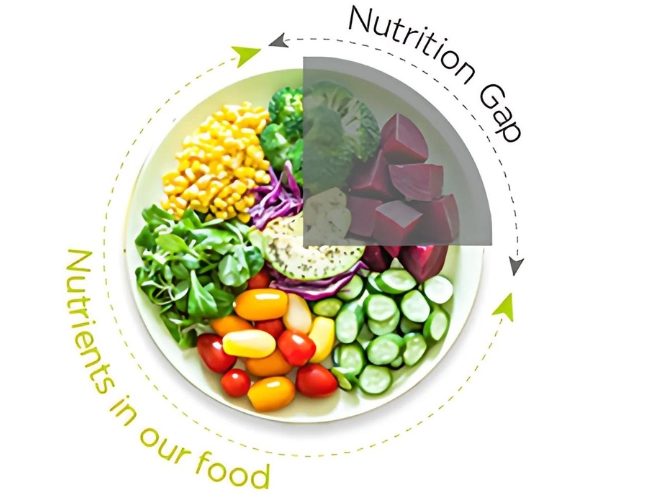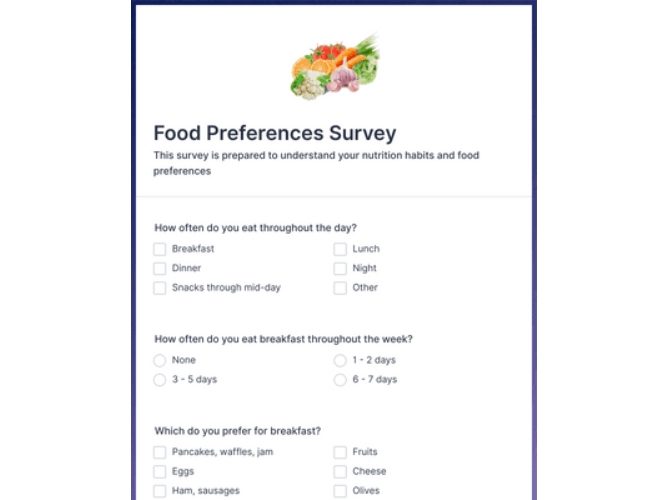Nutritionist’s Food Preference Questionnaire for Better Meals
A food preference questionnaire is an essential tool for any nutritionist or dietitian seeking to provide healthy, appetizing meals that meet clients’ requirements. Clients’ tastes, cultural background, and eating habits must be understood to effectively create a proper meal plan. By employing a well-crafted food preference questionnaire, nutritionists will be able to gain some of the key insights they need to make better decisions for customized meal planning. Read this article to help you create a strong Food Preference Questionnaire, which can guide you in gathering the right data to increase the efficiency of your meal planning process. And at the end of this article, I am sharing a sample downloadable Food Preference Questionnaire.
What Is a Food Preference?

Food preferences refers to an individual’s likes and dislikes regarding various food, flavors, and eating habits. All these preferences are determined by a complex ensemble of factors that may include personal experiences, cultural background, sensitivities of taste, and even genetic predispositions.
Understanding the food preferences of a client is also important in diet development to make it more acceptable for clients to follow. Planning of diet that meets the available food preferences or needs in a client increases the adherence of the diet to recommendations, thus improved health condition.
Role of a Food Preference Questionnaire
The basic purpose of a food preference questionnaire is to seek the eating habits, likes, and dislikes of a subject. It assists nutritionists and dietitians in many ways mentioned below:
- Tailor-Made Meals: Proper understanding of food preference helps nutritionists devise meals close to the individual tastes.
- Nutritional Gaps: When the nutritional practitioners gain insight into the food preferences, they identify the scope for necessary correction of the potential gaps in nutrition.

- Cultural and Religious Sensitivity: Most clients have cultural or religious dietary constraints that must be observed during meal planning.
- Introducing New Foods: A good questionnaire can identify ways through which healthier food choices may be accepted more willingly by the client.
- Improving Compliance: Chances of compliance with dietary recommendations may be improved if a client appreciates what the meal plan provides for him or her.
Key Elements of a Food Preference Questionnaire
A good comprehensive food preference questionnaire would include a number of crucial elements:
1. Favorites and Dislikes
Determine which are the client’s favorite and least favorite foods, and work from that information when considering options for meals. Perhaps the client has negative associations about not really liking the taste of broccoli because of its bitterness or positive ones about the versatility and sweetness of sweet potatoes.
2. Favorite Types of Cuisine
Knowing the background culture of the client and his or her choice of cuisines enables one to devise a meal plan that could be acceptable to the client in question. For instance, if the client enjoys the Indian type, this provides an opportunity to include the intake of lentils and spices in the diet.

3. Taste Preferences
Texture is regarded as one of the most elements in food consumption. Determine what types of texture do the clients like, like crunchy, smooth, chewy, or creamy. For instance, a client who prefers to consume crunchy foods may opt for salads and raw vegetables instead of mashed potatoes.
4. Cooking Method Preference
Offer the client choices based on preference in cooking. These include raw, roasted, fried, grilled, or steamed. In this aspect, a client might enjoy steamed vegetables for their flavor than those grilled.
When to Administer the Questionnaire
Administration
The food preference questionnaire should be administered at the first consultation or assessment. This is in time when you are likely to obtain critical information before the development of meal plans or making dietary recommendations.
Revisit and update this information time to time as clients could have changed their eating habits for various reasons, including health conditions, lifestyle change, or exposures to new cuisine. Keeping the data up-to-date will ensure that the meal plans remain relevant and enjoyable.
Identify Important Areas of Interest

Tailor the questionnaire to mirror the specific interests most relevant to your practice and clientele:
- Age Group: Different age groups may have different food preferences and nutritional needs.
- Common Health Conditions: If frequently you treat specific health issues, then diet questions about dietary restrictions that may be considered with these conditions.
- Cultural Diversity: Knowing the diversity of your client will guide you in the formulation of inclusive questionnaires.
- Specific Dietary Strategies: If you often prescribe specific diets (e.g., vegetarian, low-carb, Mediterranean), make sure your questions are relevant to those strategies.
Plain and Simple Questions
Write down your questions so that they are easy to understand and not full of big words or jargon that may confuse clients. Offer a mix of the following question types:
1.Multiple Choice Questions: A painless way to obtain measurable data.
What is your diet preference?
a) Vegetarian
b) Non-Vegetarian
c) Pescatarian
d) Vegan

2. Likert Scale Questions: Measure the level of likes and dislikes.
Instance: How much do you enjoy spicy food? 1-5 Scale, wherein 1 stands for Strongly dislike and 5 stands for Strongly enjoy.
3. Open-Ended Questions: Let your customers express themselves freely
Instance: What are three dishes you like most and why?
Make your questions culturally sensitive.
Eating behaviors vary from culture to culture. So, design your questionnaire keeping the cultural aspect in mind. Do not assume what normal eating is. Instead, give them options that best fit their needs based on their culture and religion. You may even ask experts on cultures or colleagues who know a variety of cultures.
Pilot Test Your Questionnaire
Before you share it with a broader audience, try your questionnaire on some of your clients or colleagues. These will give you an idea of what questions confuse them, what choices are not accounted for, and the areas that need some kind of fine-tuning. Use the insights gained from the pilot to refine your questionnaire.
Choose the Right Vehicle :
Since we live in a digital age, choose the easiest method for administering your questionnaire. Some options are:
- Paper-Based Forms:
More traditional and which some clients may prefer.

- Online Surveys:
Google Forms or SurveyMonkey makes it easier for you to disseminate and collect data.
Practice Management Software:
Some professionals integrate questionnaires in their management systems to effectively manage data.
Choose a system that you can easily use while it also reaches your client, considering data privacy and security.
Analyze and Use Data
Now that you have client food preference data, think about how you are going to analyze and apply that data. Create a summary sheet for each client that captures key preferences, restrictions, and areas for diet improvement. That summary sheet is used to individualize meal planning and nutritional recommendations, making it much more useful.
Client Follow-Up
After making the dietary changes based on the food preference questionnaire, you should often follow up with clients. With this, you are able to:

- Judge the effectiveness of the meal plans developed
- Track any problems areas or difficulties that can be caused by new dietary changes.
- Change the meal plans if there is a change in the clients’ preferences or health needs.
This should be done with the help of encouraging new diets for clients and motivating them to adapt. Then, after a number of weeks, follow-up check-ins are also scheduled to review progress and make any necessary adjustments to the dietary program.
Conclusion
I think we respect at Fitrofy that for you to have long-term health and wellness, you need to understand your food preferences. A well-designed food preference questionnaire forms the bedrock for personalized nutrition, allowing meaningful meal planning that meets individual needs, values, and taste.
Our approach is directed more towards your likes and dislikes, together with cultural factors, so as to guide you towards better choice selection wherein your diets lead toward a healthier lifestyle. We will respect your preference, and it will be not just healthy but will also enjoy the different dishes prepared.
Using our food preference survey, claim control over your health journey and create space for a path which revolves around individuality. With us, you will find your way to better health-starting with knowing your favorite foods.
Prioritize health and well-being with an easy-to-use solution! The Smart Diet Planner supports daily wellness and energy. Discover the benefits of better health habits today.
Download now or reach out at dietitian@smartdietplanner.com |
+91-7037679715 | https://business.fitrofy.com/
